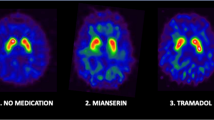Abstract
Brain dopamine transporter (DAT) imaging with [123I]FP-CIT SPECT can be used to evaluate the integrity of the mesostriatal dopaminergic system in patients with clinically uncertain parkinsonism. To evaluate whether scanning a patient is clinically necessary, it is vital to understand possible factors that affect the scanning result. Therefore, we investigated an unselected sample of 538 consecutively scanned patients from a 6-year period, and the demographic data and indications for DAT SPECT were recorded. After scanning, the patients were divided into groups according to the scanning outcome. Multivariate binary logistic regression analyses were performed to investigate whether the pre-imaging variables had independent associations with the outcome of the scan. Three hundred and three (56.3 %) patients had abnormal scans showing a dopaminergic deficit. The independent factors associated with abnormal scans were older age (p = 0.002), asymmetry of motor symptoms (p = 0.005) and shorter symptom duration (p < 0.001). Re-evaluation of the previously established Parkinson’s disease diagnosis was associated with a higher probability of an abnormal scan (74.4 % abnormal, p = 0.004), whereas the possibility of medication-induced parkinsonism was associated with a higher probability of a normal scan (35.4 %, p = 0.036). The probability of an abnormal outcome in clinical brain DAT imaging increases with known risk factors of neurodegenerative parkinsonism. However, a long duration of uncertain motor symptoms and suspicion of medication-induced parkinsonism are associated with a higher probability of a normal outcome. The findings reflect epidemiological factors in parkinsonism together with referral biases that may be used to improve the clinical use of DAT imaging.


Similar content being viewed by others

References
Bajaj N, Hauser RA, Grachev ID (2013) Clinical utility of dopamine transporter single photon emission CT (DaT-SPECT) with (123I) ioflupane in diagnosis of parkinsonian syndromes. J Neurol Neurosurg Psychiatry 84(11):1288–1295
Collier TJ, Kanaan NM, Kordower JH (2011) Ageing as a primary risk factor for Parkinson’s disease: evidence from studies of non-human primates. Nat Rev Neurosci 12(6):359–366
Colosimo C, Albanese A, Hughes AJ, de Bruin VM, Lees AJ (1995) Some specific clinical features differentiate multiple system atrophy (striatonigral variety) from Parkinson’s disease. Arch Neurol 52(3):294–298
Darcourt J, Booij J, Tatsch K, Varrone A, Vander Borght T, Kapucu OL, Någren K, Nobili F, Walker Z, Van Laere K (2010) EANM procedure guidelines for brain neurotransmission SPECT using (123)I-labelled dopamine transporter ligands, version 2. Eur J Nucl Med Mol Imaging 37(2):443–450
de la Fuente-Fernández R (2012) Role of DaTSCAN and clinical diagnosis in Parkinson disease. Neurology 78(10):696–701
Djaldetti R, Ziv I, Melamed E (2006) The mystery of motor asymmetry in Parkinson’s disease. Lancet Neurol 5(9):796–802
Kaasinen V, Kinos M, Joutsa J, Seppänen M, Noponen T (2014) Differences in striatal dopamine transporter density between tremor dominant and non-tremor Parkinson’s disease. Eur J Nucl Med Mol Imaging 41(10):1931–1937
Kaasinen V, Joutsa J, Noponen T, Johansson J, Seppänen M (2015) Effects of aging and gender on striatal and extrastriatal [123I]FP-CIT binding in Parkinson’s disease. Neurobiol Aging 36(4):1757–1763
Kraemmer J, Kovacs GG, Perju-Dumbrava L, Pirker S, Traub-Weidinger T, Pirker W (2014) Correlation of striatal dopamine transporter imaging with post mortem substantia nigra cell counts. Mov Disord 29(14):1767–1773
Niznik HB, Fogel EF, Fassos FF, Seeman P (1991) The dopamine transporter is absent in parkinsonian putamen and reduced in the caudate nucleus. J Neurochem 56(1):192–198
Seppi K, Scherfler C, Donnemiller E, Virgolini I, Schocke MF, Goebel G, Mair KJ, Boesch S, Brenneis C, Wenning GK, Poewe W (2006) Topography of dopamine transporter availability in progressive supranuclear palsy: a voxelwise [123I] beta-CIT SPECT analysis. Arch Neurol 63(8):1154–1160
Thiriez C, Itti E, Fénelon G, Evangelista E, Meignan M, Cesaro P, Remy P (2015) Clinical routine use of dopamine transporter imaging in 516 consecutive patients. J Neurol 262(4):909–915
Varrone A, Dickson JC, Tossici-Bolt L, Sera T, Asenbaum S, Booij J, Kapucu OL, Kluge A, Knudsen GM, Koulibaly PM, Nobili F, Pagani M, Sabri O, Vander Borght T, Van Laere K, Tatsch K (2013) European multicentre database of healthy controls for [123I] FP-CIT SPECT (ENC-DAT): age-related effects, gender differences and evaluation of different methods of analysis. Eur J Nucl Med Mol Imaging 40(2):213–227
Walker Z, Jaros E, Walker RW, Lee L, Costa DC, Livingston G, Ince PG, Perry R, McKeith I, Katona CL (2007) Dementia with Lewy bodies: a comparison of clinical diagnosis, FP-CIT single photon emission computed tomography imaging and autopsy. J Neurol Neurosurg Psychiatry 78(11):1176–1181
Wüllner U, Schmitz-Hübsch T, Abele M, Antony G, Bauer P, Eggert K (2007) Features of probable multiple system atrophy patients identified among 4770 patients with parkinsonism enrolled in the multicentre registry of the German Competence Network on Parkinson’s disease. J Neural Transm 114(9):1161–1165
Acknowledgments
The staff of the Department of Nuclear Medicine, Turku University Hospital, is gratefully acknowledged.
Author information
Authors and Affiliations
Corresponding author
Ethics declarations
Conflict of interest
None.
Ethical approval
The local ethical committee accepted this retrospective study protocol, and the requirement to obtain informed consent was waived. The study was conducted according to the principles of the Declaration of Helsinki.
Rights and permissions
About this article
Cite this article
Jaakkola, E., Joutsa, J. & Kaasinen, V. Predictors of normal and abnormal outcome in clinical brain dopamine transporter imaging. J Neural Transm 123, 205–209 (2016). https://doi.org/10.1007/s00702-015-1495-0
Received:
Accepted:
Published:
Issue Date:
DOI: https://doi.org/10.1007/s00702-015-1495-0



